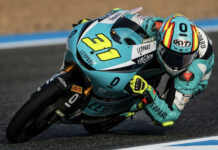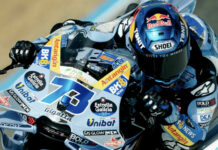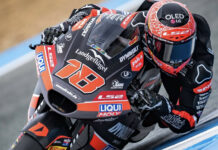From a press release issued by Team Suzuki News Service:
ROAD TO RIO CONTINUES SUZUKI’S JOURNEY
MotoGP – Round 12, Jacarepagua, Brazil, September 21, 2002.
Team Telefónica MoviStar Suzuki embarks on the long trip down south to Rio de Janeiro with high hopes, after very fruitful tests followed a “best-so-far” Portuguese GP.
Fourth was former World Champion Kenny Roberts’ best result of the season on the all-new V4 four-stroke GSV-R racer, after a dogged race in appalling conditions.
But although a similar achievement remained elusive for team-mate Sete Gibernau – robbed of certain victory when he crashed out of the lead with less than four laps to go – his superb ride had until that moment also been his best yet on the new four-stroke. The Spanish rider seized the lead on the third of 28 laps, and pulled out a decisive margin on the streaming and treacherous track, before he fell with the flag almost within sight.
Gibernau flew home to Spain directly for treatment for his injuries … no fractures, but a painful collarbone dislocation.
Roberts stayed on at Estoril for a series of tests that took the still-developing bike to another level of feel and rider-friendliness.
The big step forward started before the race, with a new Suzuki-designed slipper clutch – a device that reduces the engine braking of the high-compression four-stroke.
The latest version was hailed as a big improvement by both riders even on their first outing. That was as practice began for the GP, severely limiting time both to get the sophisticated new clutch unit set up, and also to get the bike settings dialled in to the new possibilities offered for faster and more consistent corner entry.
“We knew right away it was a step forward,” said team manager Garry Taylor. “Sete proved that with a truly superb ride. He had lapped everybody up to ninth place, and had title leader Valentino Rossi beaten when unfortunately he suffered a little glitch with big consequences.
“After the race we had the time to work on integrating the clutch, and the other improvements that keep coming from the factory, with the whole package.
“Kenny was delighted. He said it made the bike feel more like a 500. In other words, he was able to ride it much more aggressively into the corners and everywhere on the track, in spite of the extra bulk and weight of the more powerful four-stroke prototype,” Taylor concluded.
The improvements should pay big dividends in Rio, the first of four “flyaway” races that continue with a gruelling schedule taking in Japan, Malaysia and Australia within the next five weeks.
Fast, wide and very bumpy, the scenically spectacular Nelson Piquet circuit at Jacarepagua outside Rio is highly technical, and exacting both on riders and on machine set-up.
The Rio race is the 12th of 16 rounds on the MGP calendar.
KENNY ROBERTS – “GETTING CLOSER THAN EVER”
“The tests at Estoril went really well. We did a lot of stuff with the new clutch, and got it so it takes a lot of pressure off the bike. It’s the closest since the first tests in January it’s been to feeling normal for me … like a 500. It’s better into the corners, but also just generally riding. It doesn’t do what it wants to do any more. It does what I want. I hope it carries over to Rio. We went pretty well there in qualifying last year, though the rain didn’t help us on race day. I believe our bike should work pretty good there.”
SETE GIBERNAU – “GOING TO RIO WITH GOOD RHYTHM”
“In the crash at Estoril, my collarbone was dislocated, but popped back in again. It was really painful, and it’s the sort of injury, like a broken rib, where you can’t really do anything except wait for it to get better. I’ve been getting treatment, and it’s still giving me trouble, but I hope it will be better in time to let me ride well. I’ve always liked Brazil, and now we are going there with a good rhythm. Maybe it will rain … but I think we need to consider doing well in the dry, like we did in Donington Park and Brno.”
ABOUT THIS RACE
The first GP in Brazil took place in 1987, at the inland circuit of Goiania. The race stayed there for two more years, then began a troubled search for a new home as that track was no longer homologated. After several false starts and cancellations, and a single round at the F1 circuit of Interlagos at Sao Paulo, the event moved to the rebuilt Nelson Piquet circuit outside Rio in 1995. The next year saw the name change to the Rio GP for 1996 and 1997. Another late cancellation in 1998 continued the oft-interrupted history of Brazilian GP racing, but it rejoined the calendar in 1999 to resume business as usual. This year’s race is the only one apart from the Dutch TT to be held on a Saturday.
ABOUT THIS CIRCUIT
The Rio circuit was an early example of a modern trend – circuits incorporating NASCAR-style banked oval tracks, with the three-mile road-racing circuit sharing part of the tarmac. Bumps and surface-changes at these junctions further complicate an already bumpy surface, of a track much more technically challenging than the simple layout suggests. Apart from a spectacular location on reclaimed marshland, among towering granite peaks, the Nelson Piquet’s plus point is its scale. With huge grandstands adding to atmosphere, looping corners are wide and fast. Like other seldom-used tracks, the surface is hard to read. Grip varies according to temperature, and though the racing line improves with use during practice and qualifying days, the track remains very slippery off line. Accurate riding is important, and overtaking difficult.
RACE DATA
Nelson Piquet Circuit – Jacarepagua
Circuit Length: 3.065 miles / 4.933 km.
Lap Record: 1:51.928 -98.588 mph / 158.662 km/h. T Okada (Honda), 1997
2001 Race Winner: V Rossi (Honda)
2001 Race Average: 45:57.414 – 96.045 mph / 154.569 km/h
2001 Fastest Race Lap: 1:53.258, Rossi
2001 Pole Position: T Ukawa (Honda) 1:51.431
2001 Kenny Roberts: 16th, qualified Third (Telefónica MoviStar Suzuki)
2001 S Gibernau: 12th, qualified Sixth (Telefónica MoviStar Suzuki)
Suzuki Previews Rio Grand Prix
Suzuki Previews Rio Grand Prix
© 2002, Roadracing World Publishing, Inc.






